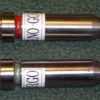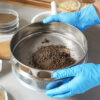Principle of operation
The Ball Mill Jar is filled with grinding media and the product to be ground. Rotation of the jar causes the grinding media and product to move around the wall of the jar creating a grinding process.
Choosing the Ball Mill Jar and Grinding Media Material
Materials available include:
Porcelain/Steatite – A hard ceramic, fairly inert when mixed with most products.
Alumina – A high alumina ceramic which is harder than porcelain but again fairly inert when mixed with most products.
Mild Steel – Hard wearing but corrodes (rusts) in water and can react with some products.
Stainless Steel – Harder than mild steel and does not corrode with most products, however, it can still react with some products.
The material should be chosen to suit the product being ground, remember that the nature of the milling process means that the inside of the jar and the grinding media wear away leaving small amounts of material in the finished product. The size of grinding media again is dependent on the product being ground; larger balls will have more impact energy but there will be a large gap between adjacent balls. Small balls will grind finer but have less impact energy and if the product is viscous are more likely to “stick” to the jar walls. It is ideal to use a mixture of different sized balls to ensure even and effective grinding. We sell Ball Charge Sets containing a mixture of ball sizes to suit different sizes of jars.
Filling the Jar
The grinding process will not work if the jar is overfilled, there must be an air gap to give the grinding media and product room to move around. Ideally, the Jar should be approx 50% by a volume full of grinding media and 25% by volume of product to be ground [measure the volume by water displacement to allow for the voids between the grinding media – balls or cylinders).
Selecting the Rolling Speed
As the jar rotates the media gets pulled up the side of the jar by friction. Rotate too slowly and the charge will only go partway up the side of the jar before rolling back down. Rotate too fast and the charge will “stick” to the jar walls by centrifugal force. The ideal speed is somewhere in between so that the balls carry almost to the top of the rotating jar and fall or “cascade” back down impacting on to the product and media below. This “cascade” effect is reached when the grinding noise is at its loudest.
Grinding Time
This is found purely by trial and error, if a very fine grind is required and time is not a critical factor then leave for several hours or overnight. To increase throughput check after a shorter time and see what grinding result has been achieved.




